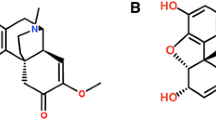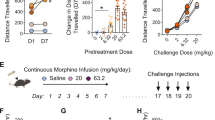Abstract
The delta opioid receptor (DOPr), whilst not the primary target of clinically used opioids, is involved in development of opioid tolerance and addiction. There is growing evidence that DOPr trafficking is involved in drug addiction, e.g., a range of studies have shown increased plasma membrane DOPr insertion during chronic treatment with opioids. The present study used a transgenic mouse model in which the C-terminal of the DOPr is tagged with enhanced-green fluorescence protein to examine the effects of chronic morphine treatment on surface membrane expression in striatal cholinergic interneurons that are implicated in motivated learning following both chronic morphine and morphine sensitization treatment schedules in male mice. A sex difference was noted throughout the anterior striatum, which was most prominent in the nucleus accumbens core region. Incontrast with previous studies in other neurons, chronic exposure to a high dose of morphine for 6 days had no effect, or slightly decreased (anterior dorsolateral striatum) surface DOPr expression. A morphine sensitization schedule produced similar results with a significant decrease in surface DOPr expression in nucleus accumbens shell. These results suggest that chronic morphine and morphine sensitisation treatment may have effects on instrumental reward-seeking behaviours and learning processes related to drug addiction, via effects on striatal DOPr function.




Similar content being viewed by others
References
Cahill CM, Holdridge SV, Morinville A (2007) Trafficking of delta-opioid receptors and other G-protein-coupled receptors: implications for pain and analgesia. Trends Pharmacol Sci 28:23–31
Gendron L, Mittal N, Beaudry H, Walwyn W (2015) Recent advances on the δ opioid receptor: from trafficking to function. Br J Pharmacol 172:403–419
Klenowski P, Morgan M, Bartlett SE (2015) The role of δ-opioid receptors in learning and memory underlying the development of addiction. Br J Pharmacol 172:297–310
Arvidsson U, Dado RJ, Riedl M, Lee JH, Law PY, Loh HH, Elde R, Wessendorf MW (1995) Delta-Opioid receptor immunoreactivity: distribution in brainstem and spinal cord, and relationship to biogenic amines and enkephalin. J Neurosci 15:1215–1235
Morinville A, Cahill CM, Kieffer B, Collier B, Beaudet A (2004) Mu-opioid receptor knockout prevents changes in delta-opioid receptor trafficking induced by chronic inflammatory pain. Pain 109:266–273
Cahill CM, Morinville A, Lee MC, Vincent JP, Collier B, Beaudet A (2001) Prolonged morphine treatment targets delta opioid receptors to neuronal plasma membranes and enhances delta-mediated antinociception. J Neurosci 21:7598–7607
Morinville A, Cahill C, Esdaile MJ, Aibak H, Collier B, Kieffer BL, Beaudet A (2003) Regulation of delta-opioid receptor trafficking via mu-opioid receptor stimulation: evidence from mu-opioid receptor knock-out mice. J Neurosci 23:4888–4898
Gendron L, Lucido AL, Mennicken F, O’Donnell D, Vincent J, Stroh T, Beaudet A (2006) Morphine and pain-related stimuli enhance cell surface availability of somatic delta-opioid receptors in rat dorsal root ganglia. J Neurosci 26:953–962
Bagley EE, Hacker J, Chefer VI, Mallet C, McNally GP, Chieng BC, Perroud J, Shippenberg TS, Christie MJ (2011) Drug-induced GABA transporter currents enhance GABA release to induce opioid withdrawal behaviors. Nat Neurosci 14:1548–1554
Lucido AL, Morinville A, Gendron L, Stroh T, Beaudet A (2005) Prolonged morphine treatment selectively increases membrane recruitment of delta-opioid receptors in mouse basal ganglia. J Mol Neurosci 25:207–214
Ma JY, Zhang Y, Kalyuzhny AE, Pan ZZ (2006) Emergence of functional δ-opioid receptors induced by long-term treatment with morphine. Mol Pharmacol 69:1137–1145
Chieng B, Christie MJ (2009) Chronic morphine treatment induces functional delta-opioid receptors in amygdala neurons that project to periaqueductal grey. Neuropharmacology 57:430–437
Ward SJ, Roberts DCS (2007) Microinjection of the delta-opioid receptor selective antagonist naltrindole 5′-isothiocyanate site specifically affects cocaine self-administration in rats responding under a progressive ratio schedule of reinforcement. Behav Brain Res 182:140–144
Marinelli PW, Funk D, Harding S, Li Z, Juzytsch W, Le AD (2009) Roles of opioid receptor subtypes in mediating alcohol-seeking induced by discrete cues and context. Eur J Neurosci 30:671–678
Chefer VI, Shippenberg TS (2009) Augmentation of morphine-induced sensitisation but reduction in morphine tolerance and reward in delta-opioid receptor knockout mice. Neuropsychopharmacol 34:887–898
June HL, McCane SR, Zink RW, Portoghese PS, Li TK, Froehlich JC (1999) The delta 2-opioid receptor antagonist naltriben reduces motivated responding for ethanol. Psychopharmacology 147:81–89
Bertran-Gonzalez J, Laurent V, Chieng BC, Christie MJ, Balleine BW (2013) Learning-related translocation of delta-opioid receptors on ventral striatal cholinergic interneurons mediates choice between goal-directed actions. J Neurosci 33:16060–16071
Laurent V, Leung B, Maidment N, Balleine BW (2012) Mu- and δ-opioid-related processes in the accumbens core and shell differentially mediate the influence of reward-guided and stimulus-guided decisions on choice. J Neurosci 32:1875–1883
Robinson TE, Berridge KC (2008) Review. The incentive sensitisation theory of addiction: some current issues. Philos Trans R Soc Lond B Biol Sci 363:3137–3146
Hogarth L, Balleine BW, Corbit LH, Killcross S (2013) Associative learning mechanisms underpinning the transition from recreational drug use to addiction. Ann N Y Acad Sci 1282:12–24
Scherrer G, Tryoen-Toth P, Filliol D, Matifas A, Laustriat D, Cao YQ, Basbaum AI, Dierich A, Vonesh JL, Gavériaux-Ruff C, Kieffer BL (2006) Knockin mice expressing fluorescent delta-opioid receptors uncover G-protein-coupled receptor dynamics in vivo. Proc Natl Acad Sci USA 103:9691–9696
Wilson MA, Mascagni F, McDonald AJ (2002) Sex differences in delta opioid receptor immunoreactivity in rat medial amygdala. Neurosci Lett 328:160–164
Williams TJ, Torres-Reveron A, Chapleau JD, Milner TA (2011) Hormonal regulation of delta opioid receptor immunoreactivity in interneurons and pyramidal cells in the rat hippocampus. Neurobiol Learn Mem 95:206–220
Loyd DR, Wang XY, Murphy AZ (2008) Sex differences in mu-opioid receptor expression in the rat midbrain periaqueductal grey are essential for eliciting sex differences in morphine analgesia. J Neurosci 28:14007–14017
Gerfen CR, Surmeier DJ (2011) Modulation of striatal projection systems by dopamine. Ann Rev Neurosci 34:441–466
Bao L, Jin SX, Zhang C, Wang LH, Xu ZZ, Zhang FX et al (2003) Activation of delta opioid receptors induces receptor insertion and neuropeptide secretion. Neuron 37:121–133
Ponterio G, Tassone A, Sciamanna G, Riahi E, Vanni V, Bonsi P et al (2013) 49 Powerful inhibitory action of mu opioid receptors (MOR) on cholinergic interneuron excitability in the dorsal striatum. Neuropharmacology 75:78–85
Chieng B, Bekkers JM (2001) Inhibition of calcium channels by opioid- and adenosine-46 receptor agonists in neurons of the nucleus accumbens. Br J Pharmacol 133:337–344
Mansour A, Fox CA, Burke S, Meng F, Thompson RC, Akil H et al (1994) Mu, delta, and kappa-opioid receptor mRNA expression in the rat CNS: an in situ hybridization study. J Comp Neurol 350:412–438
Jabourian M, Venance L, Bourgoin S, Ozon S, Perez S, Godeheu G, Glowinski J, Kemel ML (2005) Functional mu opioid receptors are expressed in cholinergic interneurons of the rat dorsal striatum: territorial specificity and diurnal variation. Eur J Neurosci 21:3301–3309
Wang H-B, Wang Q, Zhao B, Zhong Y-Q, Li K-C, Li Z-Y, Lu Y-J et al (2010) Coexpression of δ- and μ-opioid receptors in nociceptive sensory neurons. Proc Natl Acad Sci USA 107:13117–13122
Acknowledgments
This work was supported by National Institute of Mental Health Grant MH56646, National Health and Medical Research Council Grant 633267 (B.W.B.), an Australian Laureate Fellowship from the Australian Research Council (B.W.B.), and a National Health and Medical Research Council Senior Principal Research Fellowship (M.J.C.). We thank Billy Chieng for assistance and Prof. Brigitte Kieffer for DOPr-eGFP knock-in mice.
Author information
Authors and Affiliations
Corresponding author
Additional information
Special Issue: In honor of Dr. Philip Beart.
Rights and permissions
About this article
Cite this article
Leah, P.M., Heath, E.M.L., Balleine, B.W. et al. Chronic Morphine Reduces Surface Expression of δ-Opioid Receptors in Subregions of Rostral Striatum. Neurochem Res 41, 500–509 (2016). https://doi.org/10.1007/s11064-015-1638-6
Received:
Revised:
Accepted:
Published:
Issue Date:
DOI: https://doi.org/10.1007/s11064-015-1638-6




